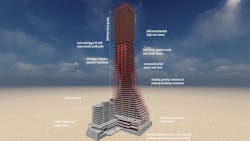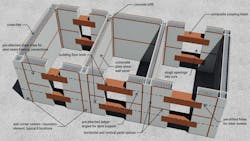Structural engineer speeds skyscraper construction with novel building core design
Over the past 50 years, high-rise construction had gone through several approaches. In the 1960s, tall buildings were braced around their perimeters, but developers and tenants objected to obstructed views, which led to a shift toward steel cores. That method, however, proved uneconomical, and was replaced, in the 1980s, by structural systems with braces of large composite columns filled with concrete.
The diameters of those columns got in the way of elevators, bathrooms, and corridors, so in the 1990s cores were built with reinforced concrete, which are how most skyscrapers are constructed today.
But construction is still dictated by how fast the core gets built. Enter Speed Core, a steel-and-concrete composite core wall system that uses two steel plates connected by steel spacing ties with a cavity between the plates filled with high-strength concrete.
Magnusson Klemencic Associates (MKA), which spearheaded the development of this concept, is using Speed Core for Rainer Square, a 1.4 million-sf, 850-foot-tall, 58-story apartment and hotel building in Seattle.
Through June, 40 stories were finished, and MKA expects construction to take 22 months, saving eight months from what it would have taken to build with a reinforced concrete core.
Ron Klemencic, PE, SE, Hon. AIA, Chairman and CEO, says his firm got the idea for Speed Core after it came across a technique developed in the United Kingdom that was used primarily for blast protection by the defense and nuclear industries.
MKA's R&D journey: A better way to build skyscrapers
In 2007, MKA engaged Purdue University, Klemencic’s alma mater, to research a new steel core system for high-rise buildings. The Charles Pankow Foundation funded the research.
It took three years to come up with a proof of concept for a composite sandwich panel, and another decade to find a client willing to try it on an actual construction project. Developer Wright Runstad & Company, a longtime MKA customer, allowed the firm to pursue this for Rainer Square. The team, which included architect NBBJ, spent six months on the design, which a panel assembled by the city of Seattle reviewed.
There are 240,000 rods used to connect the steel plates that are part of the panels. Purdue and the University of Buffalo are working on the next generation of core design, which Klemencic says might include smaller welds, thinner plates, and one-third fewer rods.
Klemencic says Speed Core aligns with MKA’s ambition to improve with every project. “With Speed Core, we’re living the dream,” he says.
MKA’s two-year-old foundation is funding research into performance-based wind engineering, reducing the carbon footprint in construction materials, and water resource management in buildings.

